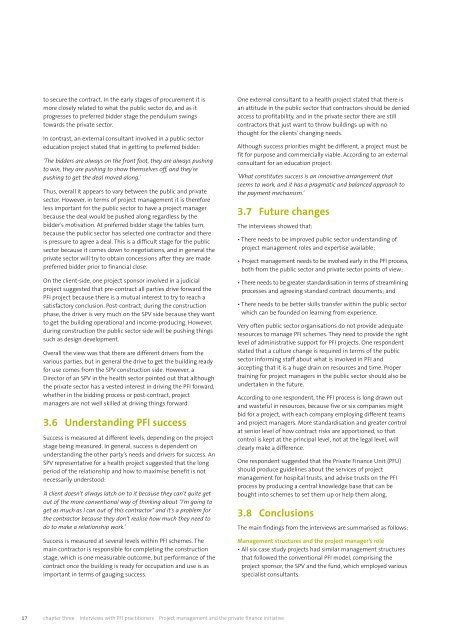Project management and the private finance initiative
Project management and the private finance initiative
Project management and the private finance initiative
Create successful ePaper yourself
Turn your PDF publications into a flip-book with our unique Google optimized e-Paper software.
to secure <strong>the</strong> contract. In <strong>the</strong> early stages of procurement it is<br />
more closely related to what <strong>the</strong> public sector do, <strong>and</strong> as it<br />
progresses to preferred bidder stage <strong>the</strong> pendulum swings<br />
towards <strong>the</strong> <strong>private</strong> sector.<br />
In contrast, an external consultant involved in a public sector<br />
education project stated that in getting to preferred bidder:<br />
‘The bidders are always on <strong>the</strong> front foot, <strong>the</strong>y are always pushing<br />
to win, <strong>the</strong>y are pushing to show <strong>the</strong>mselves off, <strong>and</strong> <strong>the</strong>y’re<br />
pushing to get <strong>the</strong> deal moved along.’<br />
Thus, overall it appears to vary between <strong>the</strong> public <strong>and</strong> <strong>private</strong><br />
sector. However, in terms of project <strong>management</strong> it is <strong>the</strong>refore<br />
less important for <strong>the</strong> public sector to have a project manager<br />
because <strong>the</strong> deal would be pushed along regardless by <strong>the</strong><br />
bidder’s motivation. At preferred bidder stage <strong>the</strong> tables turn,<br />
because <strong>the</strong> public sector has selected one contractor <strong>and</strong> <strong>the</strong>re<br />
is pressure to agree a deal. This is a difficult stage for <strong>the</strong> public<br />
sector because it comes down to negotiations, <strong>and</strong> in general <strong>the</strong><br />
<strong>private</strong> sector will try to obtain concessions after <strong>the</strong>y are made<br />
preferred bidder prior to financial close.<br />
On <strong>the</strong> client-side, one project sponsor involved in a judicial<br />
project suggested that pre-contract all parties drive forward <strong>the</strong><br />
PFI project because <strong>the</strong>re is a mutual interest to try to reach a<br />
satisfactory conclusion. Post-contract, during <strong>the</strong> construction<br />
phase, <strong>the</strong> driver is very much on <strong>the</strong> SPV side because <strong>the</strong>y want<br />
to get <strong>the</strong> building operational <strong>and</strong> income-producing. However,<br />
during construction <strong>the</strong> public sector side will be pushing things<br />
such as design development.<br />
Overall <strong>the</strong> view was that <strong>the</strong>re are different drivers from <strong>the</strong><br />
various parties, but in general <strong>the</strong> drive to get <strong>the</strong> building ready<br />
for use comes from <strong>the</strong> SPV construction side. However, a<br />
Director of an SPV in <strong>the</strong> health sector pointed out that although<br />
<strong>the</strong> <strong>private</strong> sector has a vested interest in driving <strong>the</strong> PFI forward,<br />
whe<strong>the</strong>r in <strong>the</strong> bidding process or post-contract, project<br />
managers are not well skilled at driving things forward.<br />
3.6 Underst<strong>and</strong>ing PFI success<br />
Success is measured at different levels, depending on <strong>the</strong> project<br />
stage being measured. In general, success is dependent on<br />
underst<strong>and</strong>ing <strong>the</strong> o<strong>the</strong>r party’s needs <strong>and</strong> drivers for success. An<br />
SPV representative for a health project suggested that <strong>the</strong> long<br />
period of <strong>the</strong> relationship <strong>and</strong> how to maximise benefit is not<br />
necessarily understood:<br />
‘A client doesn’t always latch on to it because <strong>the</strong>y can’t quite get<br />
out of <strong>the</strong> more conventional way of thinking about "I’m going to<br />
get as much as I can out of this contractor" <strong>and</strong> it’s a problem for<br />
<strong>the</strong> contractor because <strong>the</strong>y don’t realise how much <strong>the</strong>y need to<br />
do to make a relationship work.’<br />
Success is measured at several levels within PFI schemes. The<br />
main contractor is responsible for completing <strong>the</strong> construction<br />
stage, which is one measurable outcome, but performance of <strong>the</strong><br />
contract once <strong>the</strong> building is ready for occupation <strong>and</strong> use is as<br />
important in terms of gauging success.<br />
17 chapter three Interviews with PFI practitioners <strong>Project</strong> <strong>management</strong> <strong>and</strong> <strong>the</strong> <strong>private</strong> <strong>finance</strong> <strong>initiative</strong><br />
One external consultant to a health project stated that <strong>the</strong>re is<br />
an attitude in <strong>the</strong> public sector that contractors should be denied<br />
access to profitability, <strong>and</strong> in <strong>the</strong> <strong>private</strong> sector <strong>the</strong>re are still<br />
contractors that just want to throw buildings up with no<br />
thought for <strong>the</strong> clients’ changing needs.<br />
Although success priorities might be different, a project must be<br />
fit for purpose <strong>and</strong> commercially viable. According to an external<br />
consultant for an education project:<br />
‘What constitutes success is an innovative arrangement that<br />
seems to work, <strong>and</strong> it has a pragmatic <strong>and</strong> balanced approach to<br />
<strong>the</strong> payment mechanism.’<br />
3.7 Future changes<br />
The interviews showed that:<br />
• There needs to be improved public sector underst<strong>and</strong>ing of<br />
project <strong>management</strong> roles <strong>and</strong> expertise available;<br />
• <strong>Project</strong> <strong>management</strong> needs to be involved early in <strong>the</strong> PFI process,<br />
both from <strong>the</strong> public sector <strong>and</strong> <strong>private</strong> sector points of view;<br />
• There needs to be greater st<strong>and</strong>ardisation in terms of streamlining<br />
processes <strong>and</strong> agreeing st<strong>and</strong>ard contract documents; <strong>and</strong><br />
• There needs to be better skills transfer within <strong>the</strong> public sector<br />
which can be founded on learning from experience.<br />
Very often public sector organisations do not provide adequate<br />
resources to manage PFI schemes. They need to provide <strong>the</strong> right<br />
level of administrative support for PFI projects. One respondent<br />
stated that a culture change is required in terms of <strong>the</strong> public<br />
sector informing staff about what is involved in PFI <strong>and</strong><br />
accepting that it is a huge drain on resources <strong>and</strong> time. Proper<br />
training for project managers in <strong>the</strong> public sector should also be<br />
undertaken in <strong>the</strong> future.<br />
According to one respondent, <strong>the</strong> PFI process is long drawn out<br />
<strong>and</strong> wasteful in resources, because five or six companies might<br />
bid for a project, with each company employing different teams<br />
<strong>and</strong> project managers. More st<strong>and</strong>ardisation <strong>and</strong> greater control<br />
at senior level of how contract risks are apportioned, so that<br />
control is kept at <strong>the</strong> principal level, not at <strong>the</strong> legal level, will<br />
clearly make a difference.<br />
One respondent suggested that <strong>the</strong> Private Finance Unit (PFU)<br />
should produce guidelines about <strong>the</strong> services of project<br />
<strong>management</strong> for hospital trusts, <strong>and</strong> advise trusts on <strong>the</strong> PFI<br />
process by producing a central knowledge base that can be<br />
bought into schemes to set <strong>the</strong>m up or help <strong>the</strong>m along.<br />
3.8 Conclusions<br />
The main findings from <strong>the</strong> interviews are summarised as follows:<br />
Management structures <strong>and</strong> <strong>the</strong> project manager’s role<br />
• All six case study projects had similar <strong>management</strong> structures<br />
that followed <strong>the</strong> conventional PFI model, comprising <strong>the</strong><br />
project sponsor, <strong>the</strong> SPV <strong>and</strong> <strong>the</strong> fund, which employed various<br />
specialist consultants.

















